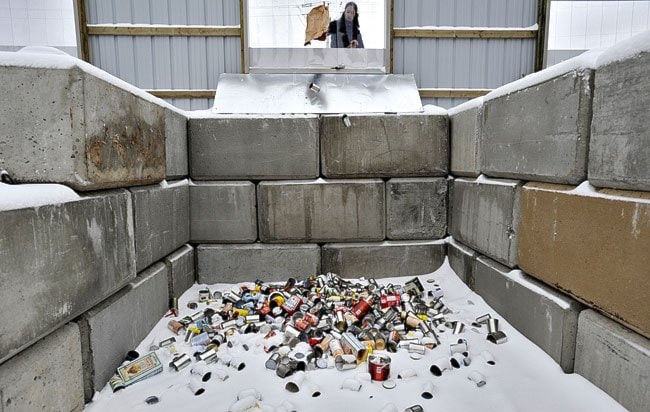Convenience is key when it comes to getting people to recycle, says Joy Snyder, executive director of Raven Recycling.
New renovations to Raven’s depot mean that customers no longer have to separate plastics or paper, so it’s certainly more convenient, but it remains to be seen if it will make a difference.
Things are always a little slower in the winter, so Raven won’t be able to tell if there was an impact until the spring, said Danny Lewis, the non-profit’s education coordinator.
In June, because the city was repaving the road, Raven had to shut down its drop-off area and move everything to its back yard.
“It was a lot less convenient for our customers and a little confusing trying to find your way in here with all the road signs, so we did taper off quite a bit,” said Lewis.
But it was also a great opportunity to get some much-needed renovations done, he said.
“It’s not very often we’re able to shut down everything.”
The interior drop-off area and the free store have been expanded, and the walls have a fresh coat of paint and some new metal cladding.
The floor was also leveled out, and a drain was installed in both the back and the front.
It not only looks cleaner, but it’ll be easier keep clean, said Lewis.
“Cleaning is a big issue in recycling,” he said. “It’s a messy business.
“Everything is lined and designed so we can hose it all down.”
Outside there’s now more parking spaces and fewer sorting bins. In fact, Raven’s gotten rid of the bins entirely.
People now drop their recyclables into brick-lined pits where it’s scooped up by a Bobcat.
Raven has also reduced the number of sorting categories from 13 to six.
[image2]
That means no more separating different kinds of paper or plastic, something people always seemed to have trouble with, said Lewis.
“Its amazing when you see people standing there with a milk jug and it says ‘milk jugs’ and the other says ‘mixed plastic,’ and they’ll hold it and say, ‘It’s a milk jug but it’s also a plastic,’ so they’ll just put it in ‘mixed,’” he said.
Without bins to move, workers now have more time to do more sorting.
“We found that our guys were pulling things off the line anyway, so this is just going to be a more convenient way of doing it and far more efficient.”
It will also allow Raven to play the market by holding commodities back when prices are low and sorting things more diligently to fetch a better price.
But the public probably won’t even notice the biggest change. Raven just got a more modern bailer.
“We’re just working on getting the electrical up and some of that fine tuning, but by the end of this month everything will be up and running and good to go,” said Lewis.
Everything Raven collects, with the exception of glass, is bailed before it’s shipped south.
With the old bailer, which they plan to keep using, all the bails have to be tied by hand. It can only do a maximum of 18 bails a day. The new bailer, which ties the bails automatically, can do about 18 bails an hour.
Not that Raven needs that kind of capacity yet.
Last year, Raven processed 2,600 tonnes of recyclables. That’s just a drop in the bucket of the city’s total waste.
With recycling and compost, Whitehorse diverts only about 19 per cent of its waste from the landfill.
The city has a goal to bring that diversion rate up to 50 per cent by 2015. It’s not an unreasonable target, said Snyder.
“To get to 50 per cent, you have to pick the low-hanging fruit, and most of that fruit is in the commercial sector rather than the residential sector,” she said. “Everyone is always saying, ‘Give me a blue box. We want blue boxes,’ but the residential only represents seven per cent of what goes into the landfill.”
Having a program to divert wood waste from construction, commercial cardboard and compostables from restaurants would easily see the city surpass a 50 per cent diversion rate, said Snyder.
And with the changes Raven’s made to its depot, Lewis feels confident that the depot will be able to handle whatever the city throws at it.
“It wasn’t our initial intention to do everything at once, but again, with that construction of the road, the opportunity to shut everything down, the deal we were able to make with the bailer, it all started to flow together, so we just went ahead and took a bit of a leap of faith,” he said.
“I think it dragged us screaming, rather than leaping,” added Snyder.
All told, Raven spent a little more than $400,000 on the renovations and upgrades, $50,000 of which came from the Yukon government.
Raven reopened its depot this week, but the official grand opening is set for Nov. 17.
There will be door prizes and a barbecue in an effort to make money for Raven’s next project: a compactor that will allow them to process Styrofoam.
Because Styrofoam is 98 per cent air, shipping it is a hassle.
An entire truckload weighs only 225 kilograms, far less than the 18,000 kilograms needed to make a shipment south worthwhile.
“It might take us six months to a year to collect enough, but if we can keep it out of the landfill, it’s well worth it,” said Lewis.
Contact Josh Kerr at
joshk@yukon-news.com
